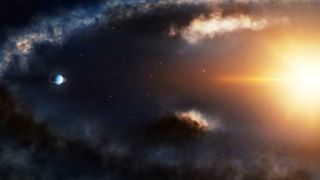Alien worlds could be discovered by hunting for debris orbiting them
It's all about celestial mechanics.

When it comes to searching for newly born planets that are tens, if not hundreds, if not thousands of light years away, we don't often get too lucky.
Planets are formed in thick clouds of dust and gas known as protoplanetary disks that swirl around a star. As such, it's very difficult to observe young planets directly through all the debris. Instead, scientists must rely on clues that might infer the presence of a protoplanet, but most of those clues are pretty circumstantial at best.
But Feng Long, a postdoctoral fellow at the Center for Astrophysics, Harvard and Smithsonian, has discovered a new clue that might indicate a protoplanet's existence: material at the Lagrange points.
Related: Hubble spots young gas giant forming in an 'intense and violent' way
Sifting through data from Chile's ALMA Observatory pertaining to protoplanetary disk LkCa 15, located some 518 light years away, she noticed "a dusty ring with two separate and bright bunches of material orbiting within it," Long said in a statement. One of those bunches was spread out into an arc, while the other took a clumpy shape.
"This arc and clump are separated by about 120 degrees," she said. "That degree of separation doesn’t just happen — it's important mathematically."
That angle suggests the two bunches of material are located at two Lagrange points. When two celestial bodies are gravitationally bound, such as a star and a planet, there are five points in space where their gravity and orbital motion essentially cancel each other out. At these Lagrange points, which are named L1 through L5, material stays put, essentially frozen in space. Based on the 120-degree angle observed between the bunches of material, Long suspects they are located at L4 and L5, with a planet located at 60 degrees between them.
Get the Space.com Newsletter
Breaking space news, the latest updates on rocket launches, skywatching events and more!
"We're seeing that this material is not just floating around freely, it's stable and has a preference where it wants to be located based on physics and the objects involved," said Long.
Current astronomy technology prohibits Long from confirming her hypothesis, but she suspects that further observations of LkCa 15 from ALMA could provide additional evidence to support it. Until then, Long hopes that others will use her technique of looking for debris at Lagrange points in order to find more potential protoplanets. "I do hope this method can be widely adopted in the future," she says.
Long's research was published in The Astrophysical Journal Letters this week.
Follow Stefanie Waldek on Twitter @StefanieWaldek. Follow us on Twitter @Spacedotcom and on Facebook.
Join our Space Forums to keep talking space on the latest missions, night sky and more! And if you have a news tip, correction or comment, let us know at: community@space.com.

Space.com contributing writer Stefanie Waldek is a self-taught space nerd and aviation geek who is passionate about all things spaceflight and astronomy. With a background in travel and design journalism, as well as a Bachelor of Arts degree from New York University, she specializes in the budding space tourism industry and Earth-based astrotourism. In her free time, you can find her watching rocket launches or looking up at the stars, wondering what is out there. Learn more about her work at www.stefaniewaldek.com.
